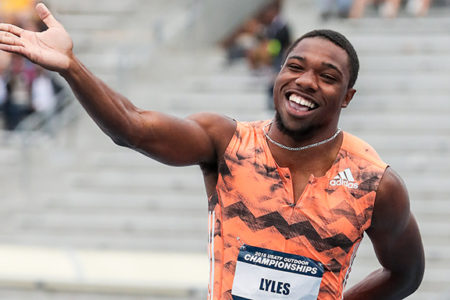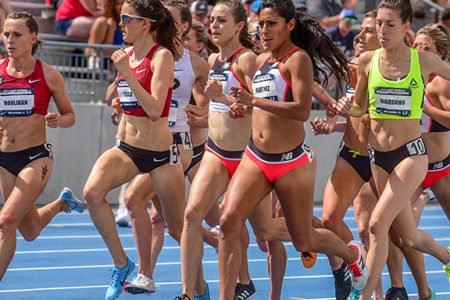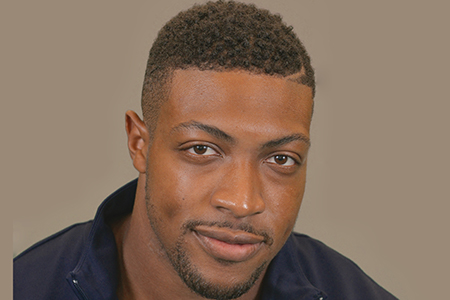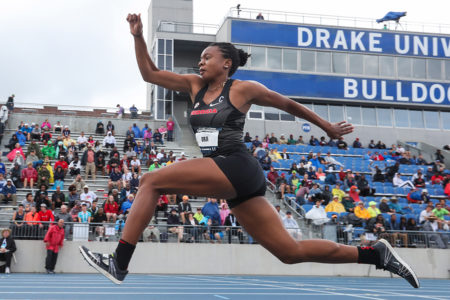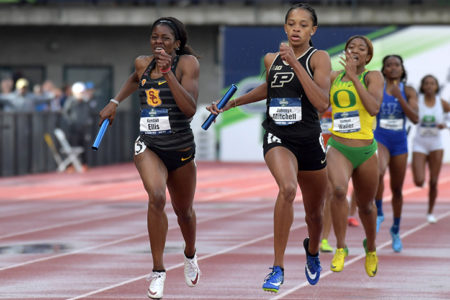Here’s this month’s collection of generally off-track activities that have gone a long way towards shaping the way the sport is headed:
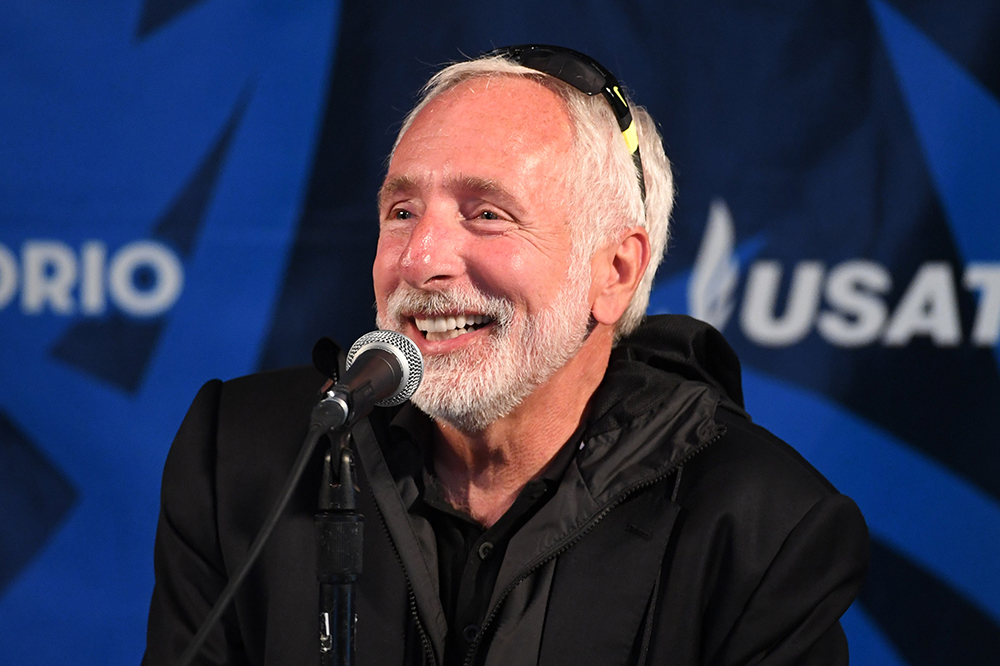
Who’s Wearing What Hats In Eugene?
A major development in Eugene: in mid-July Vin Lananna resigned as president of TrackTown USA, the organization that staged the last 3 Olympic Trials, as well as the ’14 World Juniors and the ’16 World Indoor. At the same time, Lananna resigned as chair of the ’21 Worlds organizing committee. He told the Eugene Register-Guard that the resignation has nothing to do with ongoing investigations into the bid process for that meet.
Lananna said in a letter that he had been thinking about ways to boost the sport in this country, explaining, “In order to consolidate my efforts and seize this moment, I am stepping aside as President of TrackTown USA and as Chair of the Oregon21 Local Organizing Committee. With the day-to-day operational structure of TrackTown USA and the delivery of Oregon21 in capable hands, the timing for me to transition my focus to the future of track & field could not be better.”
Kathy Herrmann (née Hayes, the ’84 NCAA 10K champ for Oregon) will take over as interim Executive Director of Oregon21, while TrackTown CEO Michael O’Reilly will lead that group. Lananna will retain his position as an Associate AD at Oregon.
Recall that Lananna has been on a USATF Board Of Directors-imposed “temporary administrative leave” from his position as that group’s president since February, reportedly because of perceived conflicts of interest. Are those conflicts now gone? In the wake of Lananna’s announcement, the BOD held a teleconference, presumably to discuss the situation, but no public announcements have been forthcoming.
Coleman Explains His Injury Woes
After a brilliant undercover campaign frosted with multiple WRs in the 60 and a World Indoor gold, Christian Coleman naturally expected a successful first-ever Diamond League season. Instead, a hamstring injury brought him down early in the going. “It was pretty tough mentally,” he told Athletics Weekly leading into the London DL. “It was something I never had to deal with.”
Starting off, he took 2nd at Pre and 4th in Rome. Then he missed 4 key DL races: Oslo, Stockholm, Paris & Lausanne, which was frustrating: “Sitting out and not training, not doing anything, just doing rehab and trying to get that right. Not being able to go full speed in practice, that’s tough mentally, especially in the middle of a season and during a season where you’ve got guys running fast.”
Finally healthy again, he raced and won a very competitive dash in Rabat in 9.98. Had he rushed the recovery? He told AW: “That’s just my competitive spirit. I was scheduled to run all these races this season and even though it didn’t go the way I wanted it to go, I hit a bump in the road, I still wanted to try and come out here and compete. That’s just the type of athlete and competitor that I am. I want to go out there and see where I am against the best in the world and throw my hat in the ring and try to prove that this is why I’m in the conversation of being the fastest guy in the world.”
Alas, the day after calling himself “100% healthy,” he pulled out of the London race when he felt his hamstring grab during warmups.
Reebok Is Back In The Game
Longtime Syracuse coach Chris Fox surprised with a mid-July announcement that had resigned from his collegiate duties, explaining, “I have an opportunity in the professional ranks that I could not refuse.” Several days later it was revealed he would be heading up the Reebok Boston TC.
Among the first signees of the club was Canadian Justyn Knight, who won two NCAA titles while at Syracuse. “I obviously know coach Fox well and I’m excited to work with him to develop and hone my skills on the track in the years to come,” he said
Also joining the group will be Jamaican Kemoy Campbell, former Penn State steepler Tori Gerlach and Syracuse alum Martin Hehir. Eventually Fox plans to eventually coach 8-10 pros as part of the group, which will be doing much of its training in Charlottesville at the facilities of the University of Virginia.
Syracuse assistant Adam Smith will join Fox in coaching the program, which represents Reebok’s first pro running team since the Reebok Enclave group of the ‘90s. Quipped Fox, “It’s not like a real job. It’s just something I’ve done since I was 13, so it’s just what I do. It’s part of my lifestyle. I want to help runners be good, and we’re going to do everything we can together to get there.”
What Future For The World Relays?
The Bahamian government has pulled the plug on Nassau’s planned hosting of the ’19 version of the World Relays. The early July decision came with the new party in charge expressing concern about the costs of hosting—some $5 million was reportedly spent on the third hosting in ’17.
Said Rosamunde Carey, head of the Bahamian federation, “It’s very unfortunate that after working so hard to make the Bahamas the destination for the World Relays that we won’t be able to host it again.” Carey also said that IAAF head Seb Coe had told her he expected a new host would be named within a week, but almost a month has gone by at this writing with no word.
Almost immediately the Jamaicans jumped into the mix, with federation president Warren Blake signaling interest but admitting they would need financial backing from their government to make National Stadium ready.
Now the Australians are also interested, though they wouldn’t be using the Commonwealth track at Gold Coast, which was torn up after this year’s Games. Said federation head Darren Gocher, “We have reached out to the IAAF to see what it would take. We have also reached out to government to see what interest there is because we would have to have government backing to fund an event of that nature. We needed to know how realistic it was from a government point of view and the feedback was generally positive as it was from the IAAF. They are prepared to be reasonably flexible.”
Oiselle Not Happy With Tori Franklin
Not often do athlete/sponsor conflicts become public, but in late June Oiselle CEO Sally Bergesen published her side of a dispute with triple jump revelation Tori Franklin. Oiselle, a women’s apparel manufacturer, had given Franklin a small ($3500) 1-year contract last fall. After her American Record in the spring, Franklin received a performance bonus that wasn’t required by the contract. However, a week before USATF, according to Bergesen, Franklin notified Oiselle that she wanted out of the contract so she could accept a better offer.
According to the Oiselle statement, “On one hand we try our hardest to always put the athlete first, but we are also running a business and need the domestic exposure that the USA Championships brings to generate the marketing benefit that allows us to justify the program. We offered to split the difference, that we needed her to honor the contract she signed with us and compete in our uniform for the US Championships, but then we would let her out of the remainder of her contract so she could compete the rest of the summer for the new sponsor—effective July 1.
“Tori, unfortunately, made the decision today with her agent to break her contract with Oiselle, go back on her word, and wear another company’s logo at the U.S. Championships. We are shocked, upset, and frankly just sad. How can we justify helping post-graduate athletes who need some time to develop, if the ones who do break through break contracts and give the initial benefit to a competitor?”
The statement concluded, “She was a wonderful athlete to sponsor, and she has a great future. We wish her the best as an athlete. But we hope that everyone realizes that failing to fulfill commitments as a business person on contracts entered into and paid for, is something that hurts the sponsors, future athletes, fans, and the sport.”
Franklin responded on Instagram, saying in part, “I am thankful for the opportunity they gave me… I am a woman that prides myself in integrity and I am a woman that prides myself in honoring my commitment, but I am also a woman who knows my worth and expects a sponsor to give me what I give them.” She said she had returned the $3500 sponsorship money.
The Latest In The Testo Wars
Was there a critical flaw in the ’17 study that led to the IAAF’s pending new regulations on females with elevated testosterone levels? That’s what three researchers maintain in a new paper. The scientists—based in the U.S., Norway and South Africa—got performance data from the original researchers in an effort to replicate their results. While their findings matched the original in some events, they found that bad data corrupted the analysis of the 400, 400H, 800 and 1500.
“Due to the pervasiveness of problematic data,” the researchers asked that the original study be retracted by the authors and the British Journal of Sports Medicine. That didn’t happen, though the BJSM published a revised article and took into account the issues raised. The IAAF stuck to its guns, saying, “The IAAF will not be seeking a retraction of the 2017 study. The conclusions remain the same.”
The University of Colorado’s Roger Pielke Jr., one of the critical researchers, told the New York Times, “This is an effort at what I would call a do-over, and it’s embarrassing and it’s not how science is expected to be done. I think this adds considerably more weight to our call for the original paper to be retracted. This is everything but putting up a billboard saying, ‘We really screwed up the data in the original study.’”
It is expected that the CAS will be taking a very close look at the underlying data as it works through the expected challenge to the IAAF rule by Caster Semenya.
IAAF Taking Hard Line On Testo Proposal
Seb Coe is standing firm on the IAAF’s proposed new regulations to deal with hyperandrogenism in female athletes. In meetings with Athletics South Africa he insisted that the science behind the rule is legitimate and it targets no specific athlete, namely Caster Semenya.
“We need to create competition categories within our sport that ensures that success is determined by talent, dedication and hard work, rather than by other factors that are not considered fair or meaningful, such as the enormous physical advantages that an adult has over a child, or a male athlete has over a female athlete,” said the international federation president.
“We therefore need to come up with a fair solution for intersex/DSD athletes wishing to compete in the female category which is what the new regulations set out to do, based on the evidence the IAAF has gathered about the degree of performance benefit that such intersex/DSD athletes get from their higher levels of circulating testosterone.”
In agreeing to disagree, South African federation head Alexck Skhosana said, “We will support our athletes on the grounds that the regulations discriminate against certain female athletes on the basis of natural physical characteristics and/or sex.”
Both sides say they will abide with whatever ruling CAS makes.
When A Record’s Not A Record
Given how sacred such marks should be, it’s great that the IAAF exercises such firm control over World Records, but for the poor athletes who come out on the short end of the “technical details” stick, the rules can surely be frustrating. This year has seen quite a collection of potential WRs (and WJRs) get swept into the IAAF dust bin, even though all remain statistically valid and appear on all-time lists.
So far in ’18 these have officially failed to pass muster:
•indoor 60: 6.37 Christian Coleman at Clemson (no false-start blocks), but at least he subsequently ran a 6.34 that was ratified);
•indoor 4×4: 3:00.77 USC at College Station (team included members from more than one country);
•indoor Junior 1500: 3:36.05 Samuel Tefera at Val de Reuil (doping test irregularities);
•indoor Junior PV: 5.83 Mondo Duplantis at Reno 12.1.18 (doping test irregularities, plus illegal pegs);
•Junior PV: 5.93 Duplantis at Baton Rouge (doping test irregularities);
•women’s 20K Walk: 1:23:39 Yelena Lashmanova at Cheboksary (no international judges) (also unclear if Russians not cleared for international competition under “authorized neutral athlete” proviso are eligible for records);
•women’s Junior indoor 400: 50.52 Sydney McLaughlin at College Station (doping test).
We hasten to note that “doping-test irregularities” should in no way be confused with failing a test or evading a sampling; it simply means a sample was either not taken or not taken in time. Note also that the IAAF’s requirements on timing of a doping test are more strict than USATF’s, so it is possible to have a ratified AR that Monaco doesn’t accept as a WR.
Pulling Back The Doping Curtain
The IAAF’s new Athletics Integrity Unit (AIU)—which replaced/expanded on the federation’s anti-doping department in April of ’17—is now operating at full speed. In July it released details on 120 ongoing cases, the vast majority involving doping offenses.
Olympic steeplechase champion Ruth Jebet is just one of the 85 cases involving Olympic or WC medalists. Nearly half of all cases involve Russians. Other notables on the list include Kenyans Asbel Kiprop and Violah Jepchumba, as well as Russian Olympic champion high jumper Ivan Ukhov. Austrian agent Robert Wagner—who is being investigated as a result of an undercover drug sting by reporters—is one of 4 functionaries on the list.
Most of the names announced are not “news,” but rather a public accounting of where each case sits in the punishment pipeline. Each major step in a doping case will now be made public: provisional suspension, first disciplinary hearing, first hearing decision, appeals & appeal decisions.
Brett Clothier, head of the AIU, said, “We are only at the beginning of our mission to restore the reputation of athletics and there is a lot more work to be done. The current and recent case load reflects the challenge we face as a sport, but also the fact we are willing to take on that challenge and drive cheats out of athletics.”
Of the 120 cases that have now been brought to life, IAAF chief Seb Coe says, “It’s too many. But let’s be clear, under the old system you wouldn’t be asking that question. We wouldn’t know the number, we wouldn’t know where we were in that process. So it’s good that we are transparent about the challenge, we are not skirting the challenge. I’d rather face the embarrassment of facing the question than the genteel decline and obfuscation of the sport.”
The Woes Pile Up For De Grasse
The breakout sprint star of ’15 & ’16, Andre De Grasse has struggled ever since suffering a grade 2 right hamstring strain in the buildup to the ’17 Worlds, which he ended up missing. He had hit bests of only 10.15 and 20.46 in a short, winless season going into the Canadian Championships, and after placing 3rd in the 100 he felt his right hamstring grab in a 200 semi and he slowed to a walk.
“I’m not sure what happened,” he said. “I think it was just a cramp hopefully. I ran a good 150 and then all of a sudden it just surprised me.” But an MRI showed a grade 1 strain in the biceps femoris (upper hamstring); though less serious than his ’17 injury, it sufficed to end his season.
In a released statement, De Grasse said, “2018 will always be the year I look back at fondly as the year my daughter came into the world. I believe the issues I’ve faced these past 12 months have made me hungrier. I will heal quickly from this injury. I will go be with my daughter and focus on being a dad for the next few weeks as I heal, and I will plan to come back stronger than ever.”
Previous to the injury De Grasse—who has been training with ALTIS in Arizona—was the subject of rampant speculation after being seen training in Toronto with former mentor Tony Sharpe, sparking reports that he had split with coach Stuart McMillan.
In an email to CBC Sports, Doyle Management, which represents De Grasse, denied the report, saying, “Andre’s splitting with Stuart McMillan and the ALTIS training group is complete speculation and unfounded. Andre has been spending more time in Toronto for treatment, sponsor commitments and for his foundation launch.”
McMillan, when asked about the reported rift, responded, “That’s news to me.”
Putting The Uniform Back In Uniform
Starting next year, NCAA tracksters will apparently have to be a bit more worried about what uniforms they’re wearing. High schoolers, though, can breathe a bit easier.
The NCAA’s T&F Rules Committee has recommended that all members of college track teams start wearing the same uniforms, starting with the 2018–19 school year. All uniforms must be the primary color of the team and have the same school logo on the top part of the garment. The committee says it didn’t want to disqualify athletes who violate this proposed rule, but they also want to make it clear that competition will not be delayed for athletes who break the rule.
“If the event is set to go off at 1 o’clock, and you’re not compliant, then you aren’t competing in that event,” said Dan Rose, committee chair and associate athletics director at Coast Guard. “The success of this uniform rule will be shared governance between coaches and meet management.”
This ruling needs to be confirmed by an NCAA oversight panel in August. It can’t come soon enough for T&FN editor E. Garry Hill, who has railed on the topic before.
Meanwhile, the national HS federation has eased up on the long-confusing rules surrounding undergarments. Now any visible garment—from t-shirts to leggings—underneath the school’s official uniform will be considered a foundation garment, and as such is not subject to restrictions on color or logo rules. Now prep officials can concentrate on officiating and stop worrying so much about fashion issues. □
